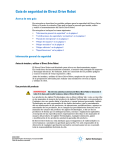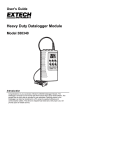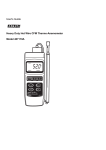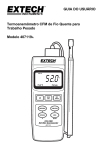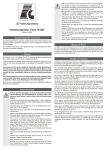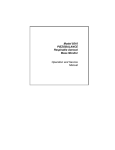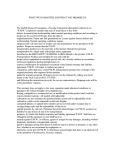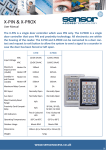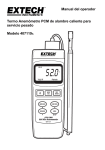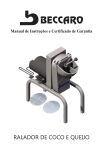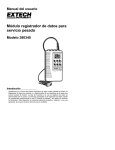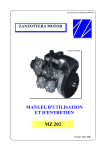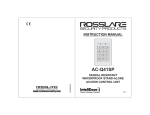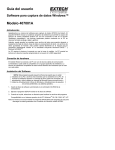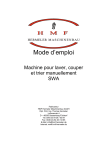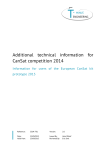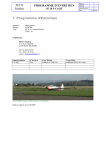Download Appendices - UAV Engine Test Stand
Transcript
APPENDIX A – HARDWARE AND SENSORS A.1 Dynamometer A.2 Remote Throttle Control A.3 02 Sensors A.4 Thermocouples A.5 Pressure Sensor A.6 Ambient Temperature and Humidity Monitor A.7 Hot Wire Anemometer A.8 Digital Manometer A.9 Fuel Flow Meter A.10 DAQ System Page | 62 A.1 Dynamometer Kahn 101-80 Dynamometer Page | 63 Lubricating Oil Oil Reservoir Capacity Air Requirements Air Supply Pressure Water Flow* Supply Pressure Max. Inlet Temperature Max. Outlet Temperature Filtration Seal Water Flow *at delta t = 50°F (28°C) 6 gal/hr hp (30 l/hr kW) 50 psig (3.5 bar) 90°F (32°C) 140°F (60°C) 40 mesh screen 0.1 gal/min (0.4 l/min) MIL-L-7808 or Mobil DTE 24 19 oz. (.56 l) max. 20 scfm dry air 50-100 psig (3.5-7.0 bar) CAPACITY, hp CAPACITY, hp 14,000 SPEED, rpm SPEED, rpm No. 1799A Printed in U.S.A. A.2 Remote Throttle Control Dynesystems DTC-1 Digital Throttle Controller Page | 64 DyneSystems Midwest & Dynamatic Dynamometers DTC-1 Digital Throttle Controller User’s Manual Revised November 2001 © 2001 Dyne Systems Co., LLC All Rights Reserved DyneSystems Co. Contact Information Shipping Address: W209 N17391 Industrial Drive Jackson, WI 53037 Mailing Address: P.O. Box 18 Jackson, WI 53037 Toll Free Phone: (800)657-0726 Fax: (262)677-9308 Web: www.dynesystems.com No part of this manual may be reproduced or transmitted in any form or by any means, including photocopying, recording, or using information storage and retrieval systems, for any purpose other than the purchaser's own use, without the express written permission of Dyne Systems Co., LLC. 2001 by Dyne Systems Co., LLC. All Rights Reserved. Any other product names and services identified in this manual are trademarks or registered trademarks of their respective owners. No such uses, or the use of any trade name, is intended to convey endorsement or other affiliation with Dyne Systems Co., LLC. Revision History Item #: MAN-DTC1-00001 May, 2001 Initial Version Table of Contents Chapter 1 – Specifications Specifications . . . . . . . . . . . . . . . . . . . . . . . . . . . . . . . . . . . . . . . . . . . . . . . . . . . Control Enclosure . . . . . . . . . . . . . . . . . . . . . . . . . . . . . . . . . . . . . . . . . . . . . Control Output . . . . . . . . . . . . . . . . . . . . . . . . . . . . . . . . . . . . . . . . . . . . . . . Environmental. . . . . . . . . . . . . . . . . . . . . . . . . . . . . . . . . . . . . . . . . . . . . . . . Power Fail Protection . . . . . . . . . . . . . . . . . . . . . . . . . . . . . . . . . . . . . . . . . . Actuator Assembly . . . . . . . . . . . . . . . . . . . . . . . . . . . . . . . . . . . . . . . . . . . . Actuator Stroke . . . . . . . . . . . . . . . . . . . . . . . . . . . . . . . . . . . . . . . . . . . . . . . Closed Loop Control. . . . . . . . . . . . . . . . . . . . . . . . . . . . . . . . . . . . . . . . . . . Function Keys . . . . . . . . . . . . . . . . . . . . . . . . . . . . . . . . . . . . . . . . . . . . . . . . Remote Operators’ Control. . . . . . . . . . . . . . . . . . . . . . . . . . . . . . . . . . . . . . Computer Control . . . . . . . . . . . . . . . . . . . . . . . . . . . . . . . . . . . . . . . . . . . . . Dyn-Loc Basic . . . . . . . . . . . . . . . . . . . . . . . . . . . . . . . . . . . . . . . . . . . . . . . Auxiliary I/O. . . . . . . . . . . . . . . . . . . . . . . . . . . . . . . . . . . . . . . . . . . . . . . . . Fault Control . . . . . . . . . . . . . . . . . . . . . . . . . . . . . . . . . . . . . . . . . . . . . . . . . 1-1 1-1 1-1 1-1 1-2 1-2 1-2 1-2 1-2 1-2 1-3 1-3 1-3 1-3 Chapter 2 – Installation Instructions Signal Wiring . . . . . . . . . . . . . . . . . . . . . . . . . . . . . . . . . . . . . . . . . . . . . . . . MS Connectors General Information . . . . . . . . . . . . . . . . . . . . . . . . . . . . . . Sub-D Type Connectors General Information . . . . . . . . . . . . . . . . . . . . . . . 120 VAC Power . . . . . . . . . . . . . . . . . . . . . . . . . . . . . . . . . . . . . . . . . . . . . . Mechanical Installation of the Actuator . . . . . . . . . . . . . . . . . . . . . . . . . . . . Connecting the DTC to the Actuator . . . . . . . . . . . . . . . . . . . . . . . . . . . . . . Connecting the Remote DTC . . . . . . . . . . . . . . . . . . . . . . . . . . . . . . . . . . . . Connecting the DTC to the Dyn-Loc . . . . . . . . . . . . . . . . . . . . . . . . . . . . . . Connecting for Stand-Alone Operation . . . . . . . . . . . . . . . . . . . . . . . . . . . . DS303C DIP Switch Settings . . . . . . . . . . . . . . . . . . . . . . . . . . . . . . . . . 2-1 2-1 2-1 2-2 2-2 2-2 2-4 2-4 2-4 2-4 i Chapter Specifications 1.0 Introduction The DTC-1 controls throttle position, RPM, TQ, MAP, or manifold vacuum to ±1 unit accuracy, providing zero regulation and drift of digital setpoints. 16 sets of PID parameters allow the DTC-1 to be adjusted to variations in engine under test or in engine operating point. Teamed with Dyne Systems’ Dyn-Loc IV dynamometer controller, all provisions are made for reference and feedback data, instrumentation, and automation control. The DTC-1 may also be used in a stand-alone situation. 2.0 Specifications 2.1 Control Enclosure • Dimensions: 19" x 7" x 13" rack or bench mounted enclosure. • Weight: 20 pounds. • Input Power: 120VAC @ 1 amp. 2.2 Control Output ±20VDC @ 3A max., Actuator Servo Motor drive. Amplifier has instantaneous current limit, and over temperature shutdown. Digital Encoder Excitation: +5VDC @ 50 ma. This feeds only Dyn-Loc’s actuator which is considered part of the DTC-1. 2.3 Environmental • +10 to +40 DegC ambient temperature range. • Humidity to 95%, non-condensing. 1.1 Chapter 1 Specifications 2.4 Power Fail Protection NICAD battery-backed DC. DC power supplies allow throttle return to idle and orderly system shutdown. 2.5 Actuator Assembly • • • • Housing Dimensions: 8"L x 3-1/4"D x 3/8" Wall cylinder. Foot mounted, 3-1/2" x 2" bolt pattern. Drip Proof for Wash-Down protection. Actuator: DC Servo Motor/Gearhead/Encoder assembly. 2.6 Actuator Stroke • • • • Maximum Stroke Length: 4". Minimum Stroke Length: 1". Maximum Stroke Angle: 70º. Maximum Stroke Torque: 2.5 lb-ft. (standard), 5.00 lb-ft. and 10.00 lb-ft. (optional). 2.7 Closed Loop Control • • • • • • • • Highly adaptive, optimum response for all engine conditions. Position control, digital, to 0.1% of stroke. Torque control, digital to 10,000 lb-ft. RPM control, digital, to 25,000 RPM. (Programmable PPR Factor) Manifold vacuum: 0 to 29 In. Hg. or MAP control: 0 to 150.00 kpa. 0% regulation and drift from set-point. RPM and torque feedback, and logic signals available from Dyn-Loc, or customer sources. Closed loop control coefficients programmable in setup mode, 16 sets. 2.8 Function Keys Four programmable function keys may be used from Dyn-Loc basic programs or as Dyne Systems customized keys. 2.9 Remote Operators’ Control • In 7" x 9" x 4" Nema 12 enclosure. • Provides upper and lower limit set-up, jog PB, and DTC soft shutdown. 1.2 Specifications MAN-DTC1-00001 Chapter 1 Specifications 2.10 Computer Control • • • • • Programming language: Dyn-Loc Basic. Computer control over RS232 serial link, with or without the Dyn-Loc IV control. Serial link parameters are settable in DTC setup mode. Automatic stand-alone control using internal battery ram 64K NVRAM. Analog reference option includes parallel mode control. 2.11 Dyn-Loc Basic Programs may be downloaded over serial link at up to 19.2K baud for stand-alone operation. 2.12 Auxiliary I/O • • • • • • • • Customer emergency stop input. Customer soft shutdown (close throttle) input logic. Analog feedback input, may be used for torque or RPM feedback. Magnetic pickup input. Analog reference input, 0 to +10VDC; 12 bit conversion, optional card. 8 bit digital I/O to DS302 PCB: optical logic/power control, optional card. Buffered expansion bus for new/custom I/O. 0 to +10 VDC analog output representing actuator position, optional card (can be used for electronic throttles). 2.13 Fault Control • • • • • All fault conditions (except amplifier over-temperature) serviced with HELP screen. Software stall detection and shutdown, prevents motor damage. All critical device connectors interlocked. Unloaded engine overspeed trip programmable RPM. Dyno control/DTC mode conflicts are trapped and displayed. MAN-DTC1-00001 Specifications 1.3 A.3 02 Sensors Bosch Lambda Sensor LSU 4.9 ETAS ES430 Lambda Module Page | 65 Lambda Sensor LSU 4.9 This sensor is designed to measure the oxygen content and λ-value of exhaust gases in automotive engines (gasoline or Diesel). The wide band lambda sensor LSU 4.9 is a planar ZrO2 dual cell limiting current sensor with integrated heater. Its monotonic output signal in the range of λ = 0,65 to air makes the LSU capable of being used as an universal sensor for λ = 1 measurement as well as for other λ ranges. The connector module contains a trimming resistor, which defines the characteristic of the sensor. The LSU operates only in combination with a special LSU-IC, used in most Bosch Motorsport ECUs and lambda control boxes (LT4). Application Application Fuel Exhaust Gas Pressure Mechanical Data 0,65 … ∞ 120 g Length 84 mm < 4 bar Thread M18 x 1,5 Exhaust Gas Temperature Range (Operating) < 930 °C Exhaust Gas Temperature Range (Maximum) < 1030 °C Wrench Size Hexagon Temperature < 600 °C Cable and protective Sleeve Temperature < 250 °C Connector Temperature < 140 °C Storage Temperature Range Weight w/o Cable Fuel/Diesel -40 … 100 °C Tightening Torque 22 mm 40 … 60 Nm Electrical Data Power Supply H+ Nominal 7,5 V System Supply Voltage H+ (min) 10,8 V Heater Power steady state 7,5 W Heater Control Frequency ≥ 100 Hz Nominal Resistance of Nernst Cell 300 Ohm Max. Vibration (stochastic peak level) < 100 g 31 Oct. 07 [email protected] Max Current load for Nernst Cell 250 µA 1/2 Connectors and Cables Characteristic Connector AS 6-07-35PN Signal Output Ip meas / Ua (AWS) Connector Loom AS 6-07-35SN Accuracy @ lambda = 1 1,016 +/- 0,007 Pin 1 Uh+ Accuracy @ lambda = 0,8 0,80 +/- 0,01 Pin 2 Uh- Accuracy @ lambda = 1,7 1,70 +/- 0,05 Pin 3 APE Pin 4 IPN Pin 5 RE Pin 6 R IP UA [V] Lambda -1,243 0,192 0,750 -0,927 0,525 0,800 -0,800 0,658 0,822 -0,652 0,814 0,850 -0,405 1,074 0,900 -0,183 1,307 0,950 Application Hint -0,106 1,388 0,970 The LSU4.9 can be connected to all Bosch Motorsport ECUs (MS 4, MS 5, MS 15) and lambda control units like LT4. -0,040 1,458 0,990 0,000 1,500 1,003 0,015 1,515 1,010 0,097 1,602 1,050 0,193 1,703 1,100 0,250 1,763 1,132 0,329 1,846 1,179 0,671 2,206 1,429 0,938 2,487 1,701 1,150 2,710 1,990 1,385 2,958 2,434 1,700 3,289 3,413 2,000 3,605 5,391 2,150 3,762 7,506 2,250 3,868 10,119 Sleeve Fiber Glas / Silicone coated Cable Size Cable Length L 22 30 … 100 cm The lambda sensor should be installed at point which permits the measurement of a representative exhaust-gas mixture, which does not exceed the maximum permissible temperature. Install at a point where the gas is as hot as possible. Observe the maximum permissible temperature. As far as possible install the sensor vertically (cable upwards). The sensor is not to be fitted near to the exhaust pipe outlet, so that the influence of the outside air can be ruled out. The exhaust-gas passage opposite the sensor must be free of leaks in order to avoid the effects of leakair. Protect the sensor against condensation water. The sensor is not to be painted, nor is wax to be applied or any other forms of treatment. Use only the recommended grease for lubricating the thread. Part Number LSU 4.9 B 261 209 356 [email protected] 2/2 Please find further application hints in the offer drawing (http://www.bosch-motorsport.com). 31 Oct. 07 ES430 Lambda Module Functions at a Glance Supports LSU 4.9 Lambda Sensor Measures lambda, 1/lambda, air-fuel ratio, fuel-air ratio, oxygen content, and pump current Linearized analog output Easily configurable to support different fuels or combustion types Automatic detection of sensor or wiring failures Operating temperature from -40 °C to 120 °C (-40 °F to 248 °F) Rugged waterproof and dustproof housing (IP67) Very small form factor and smart stacking concept Scalable daisy chained measurement setups Open protocol (XCP-on-Ethernet) Rugged Lambda Measurement The robust ES430 Lambda Module has been designed to be installed in close proximity to the lambda sensor. The ES430 is capable of withstanding the environmental conditions which are typical for exhaust system installations. The ES430 Lambda Module provides lambda (λ) as well as 1/λ, air-fuel ratio (A/F), fuel-air ratio (F/A), oxygen content (O2), and pump current (Ip) measurements through the use of the Bosch LSU 4.9 lambda sensor. The measurement values are calculated from the sensor signal using a sensor- and combustion-specific characteristic curve (linearization). The sampling rate of the signal is software configurable in the range from 0.5 Hz to 2 kHz. The ES430 provides the host system with multiple types of digital measurement signals simultaneously. In addition, one linearized signal can be put out as analog voltage. The ES430 operates the LSU 4.9 sensor at a constant temperature to ensure measurement accuracy. To prevent damage or degradation of the sensor element, the ES430 provides for heating of the λ sensor even during standby mode. Standby is automatically entered when the module is disconnected from the host PC application. In addition, a mechanism is provided to identify the type of sensor connected via the splitter cable. This eliminates potential errors due to the use of incorrect characteristic parameters. Open Integration The standardized XCP-on-Ethernet protocol is used for data transfer. Configuration and integration tools provide for an easy integration of the ES430 Lambda Module into measurement and development tools. A LabVIEW® driver as well as a C-based library are available for integration into software applications that don‘t provide any XCP-on-Ethernet driver functionality. Time-Synchronous Data The 100 Mbit/s Ethernet link can transfer mea surement data from several ES400 modules with a sampling rate of up to 10 kHz. All modules in a measuring system – whether an ES400 chain, multiple ES400 chains, or a configuration including ES600 measurement modules – are synchronized with an accuracy of 1 µs. In combination with an ETAS ECU and bus interface such as an ES590 module, Lambda sensor and ECU data can be acquired easily and synchronized accurately. Technical Data1 Item Characteristics Features Dimension (HxWxD) Weight 51 x 40 x 139 mm / 2.0 x 1.6 x 5.5 in 37 x 40 x 124 mm / 1.5 x 1.6 x 4.9 in (tapered rear) 350 g / 0.77 lb General Environment Temperature range Protection class Altitude Tested for -40 °C to +120 °C (-40 °F to +248 °F) (operation) -40 °C to +125 °C (-40 °F to +257 °F) (storage) IP67 (with cables connected) Up to 5000 m / 16,400 ft Mechanical shock, vibration, fall, temperature shock, temp- erature alteration, storage in humidity, salt fog attack, impact from flying rocks, according to DIN EN 60068 res. ISO 16750 Power supply Host interface Operating voltage Power consumption (at 12 V) Connection and protocol IP address Measurement signal types (signals can be provided concurrently to host system for each input channel) 5 V to 50 V DC (-40 °C .. 85 °C), 6 V to 50 V DC (+85 °C .. 120 °C) 2.0 W typ. (operation), 200 mW typ. (standby) Sensor Channels connection Supported sensor types Sensor connection Sampling rate Heater control Measurement range Analog output Channels Range Signal types Output impedance Software ETAS GmbH 70469 Stuttgart, Germany Phone +49 711 89661-0 Fax +49 711 89661-106 [email protected] 100 Mbit/s Base-T Ethernet, Full-Duplex required, XCP-on-UDP/IP Dynamic via INCA or config. tool (default 192.168.40.44) Lambda (λ), 1/λ, air-fuel ratio (A/F), fuel-air ratio (F/A), oxygen content (O2), and pump current of the λ sensor (Ip). For diagnostic purposes: internal resistance of the λ sensor (Ri) 1 Robert Bosch LSU 4.9, automatically detected via splitter cable RB150, Code 1 0.5 Samples/s to 2 kSamples/s, Ri is measured with 2 Samples/s Included; configurable to keep sensor in operation also in module standby mode λ: 0.6 to 16 1/λ: 1.67 to 0.0625 A/F: 8.5 to 200 F/A: 0.118 to 0.005 O2: 0 % to 25 % Ip: -2.5 mA to 5 mA Ri: 0 Ohm to 1950 Ohm 1, electrically isolated to any supply 0 V to 10 V λ, 1/λ, A/F, F/A, O2, or Ip, configurable by software Virtually 0 Ohm, short-circuit protected against external voltage of up to 28 V Supported by INCA V5.4.1 and up via add-on (part of ES430 delivery), INTECRIO V3.x, ES400 configura- tion and integration tool for XCP applications, C-based library available for integration into software applications that don‘t provide any XCP-on-Ethernet driver functionality, LabVIEW® driver (Q1/2008). Ordering Information Order Name Short Name Order Number Lambda Module (1-CH) Optional Accessories Lambda Sensor Cable for LSU4.9 with RB150 Plug Code 1, with analog output connector, (22mc-6fc), 3 m/ 9.8 ft Lambda Sensor Cable for LSU4.9 with RB150 Plug Code 1, without analog output connector, (22mc-6fc), 3 m/ 9.8 ft Lambda Sensor LSU4.9, SR4 Cap to protect unused Souriau sockets ES430.1 F-00K-105-922 CBAL451.1-3 F-00K-105-926 CBAL452.1-3 F-00K-106-127 LSUS_49 CAP_SOURIAU_8STA 0-258-017-025 F-00K-105-303 For ES400 system cables and accessories, please refer to the ETAS Product and Service Catalog. ETAS S.A.S. 94588 Rungis Cedex, France Phone +33 1 56 70 00 50 Fax +33 1 56 70 00 51 [email protected] ETAS Ltd. Burton-upon-Trent Staffordshire DE14 2WQ Great Britain Phone +44 1283 54 65 12 Fax +44 1283 54 87 67 [email protected] ETAS Inc. Ann Arbor, MI 48103, USA Phone +1 888 ETAS INC Fax +1 734 997-9449 [email protected] ETAS K.K. Yokohama 220-6217, Japan Phone +81 45 222-0900 Fax +81 45 222-0956 [email protected] ETAS Korea Co., Ltd. Seoul 137-889, Korea Phone +82 2 57 47-016 Fax +82 2 57 47-120 [email protected] ETAS (Shanghai) Co., Ltd. Shanghai 200120, P.R. China Phone +86 21 5037 2220 Fax +86 21 5037 2221 [email protected] ETAS Automotive India Pvt. Ltd. Bangalore, Karnataka 560 068 India Phone +91 80 4191 2585 Fax +91 80 4191 2586 [email protected] www.etas.com 1 Technical Data are rated for 25 °C unless otherwise noted. All accuracy specifications valid for the first year after delivery. Contact addresses ETAS/MKT61_Sar/02.2008 A.4 Thermocouples Omega 5TC Ready-made Insulated Thermocouples Page | 66 Ready-Made Insulated Thermocouples ANSI color code shown To order IEC color code see page A-9 Custom InsulatioLengths, Configu ns, and ra Availabtions le with Stripped Leads 5-TC Series Starts at 33 $ See Section I 5 Pack Shown smaller than actual size. ⻬ Available from Stock in Convenient 5-Packs ⻬ PFA, Kapton®, or Glass Braid Insulation ⻬ 20, 24, 30, 36 and 40 AWG Wires ⻬ 1 and 2 m (40 and 80") Lengths Standard ⻬ NIST Calibration Available ⻬ OEM Quantities Available Also Available TAP Adhesive Labels! Thermocouple Adhesive Labels secure wire probes to surfaces. TAP adhesive labels have a thickness of 0.064 mm (0.0022") and can be used at a maximum temperature of 180°C (356°F). They are made of a polymide film with a silicone pressure sensitive adhesive. Please see page F-16 for additional details and ordering information. Model TAP, roll of 100 adhesive labels, $28, shown smaller than actual size. “TT” PFA insulation MOST POPULAR MODELS HIGHLIGHTED! To Order (Specify Model Number) “GG” Glass braid insulation Fine 40-Gage KAPTON® PFA Wire Insulation Price, Pack of 5 1m 2m (40") (80") Model No. ANSI Color Code AWG Gage Diameter mm (in) Insulation 5TC-GG-(*)-20-(**) 20 0.81 (0.032") Glass Braid $39 $49 5TC-GG-(*)-24-(**) 24 0.51 (0.020") Glass Braid 33 43 5TC-GG-(*)-30-(**) 30 0.25 (0.010") Glass Braid 33 43 5TC-TT-(*)-20-(**) 20 0.81 (0.032") PFA 50 70 5TC-TT-(*)-24-(**) 24 0.51 (0.020") PFA 39 49 5TC-TT-(*)-30-(**) 30 0.25 (0.010") PFA 44 64 5TC-TT-(*)-36-(**) 36 0.13 (0.005") PFA 50 70 5TC-TT-(*)-40-(**) 40 0.08 (0.003") PFA 60 80 5TC-KK-(*)-20-(**) 20 0.81 (0.032") ® Kapton 71 99 5TC-KK-(*)-24-(**) 24 0.51 (0.020") Kapton® 55 69 5TC-KK-(*)-30-(**) 30 0.25 (0.010") Kapton 85 113 ® * Insert calibration J, K, T, or E. ** Specify length, insert “36” for 1 m or “72” for 2 m length. Note: For GG or TT wire, add $5 per additional 300 mm (12") per package of 5. For KK wire, add $8 per additional 300 mm (12") per package of 5. Ordering Example: 5TC-TT-K-36-36, 5 each, PFA insulated thermocouples, Type K calibration (CHROMEGA®-ALOMEGA®), 36 AWG, 1 m (40") long, stripped lead termination, $50. A-21 A.5 Pressure Sensor Motorola MPX4115A Integrated Silicon Pressure Sensors Page | 67 Freescale Semiconductor, Inc. Order this document by MPX4115A/D SEMICONDUCTOR TECHNICAL DATA Freescale Semiconductor, Inc... $"$ "##%" # " " # %$ "##%" $$" " " $" !!$ # ! $ !"$%" !#$ INTEGRATED "$ Motorola’s MPX4115A/MPXA4115A series sensor integrates on–chip, bipolar op amp circuitry and thin film resistor networks to provide a high output signal and temperature compensation. The small form factor and high reliability of on–chip integration make the Motorola pressure sensor a logical and economical choice for the system designer. The MPX4115A/MPXA4115A series piezoresistive transducer is a state–of–the–art, monolithic, signal conditioned, silicon pressure sensor. This sensor combines advanced micromachining techniques, thin film metallization, and bipolar semiconductor processing to provide an accurate, high level analog output signal that is proportional to applied pressure. Figure 1 shows a block diagram of the internal circuitry integrated on a pressure sensor chip. PRESSURE SENSOR 15 to 115 kPa (2.2 to 16.7 psi) 0.2 to 4.8 Volts Output UNIBODY PACKAGE Features • 1.5% Maximum Error over 0° to 85°C MPX4115A CASE 867 • Ideally suited for Microprocessor or Microcontroller– Based Systems • Temperature Compensated from –40° to +125°C • Durable Epoxy Unibody Element or Thermoplastic (PPS) Surface Mount Package Application Examples SMALL OUTLINE PACKAGE • Aviation Altimeters • Industrial Controls • Engine Control • Weather Stations and Weather Reporting Devices *' (" ! (!$&()& #!$"'(#" " " '( '"'" !"( " " '( " &#)" &&" '( &)(&- *9>= MPXA4115AC6U CASE 482A $"' " & "# #""(' #& '! #)( " $ * $"' " & "# #""(' #& )"#- * Figure 1. Fully Integrated Pressure Sensor Schematic REV 4 Motorola Sensor Device Data Motorola, Inc. 2001 MPX4115AP CASE 867B MPXA4115A6U CASE 482 MPX4115AS CASE 867E PIN NUMBER 1 PIN NUMBER N/C 5 N/C 1 Vout 4 N/C 2 VS 6 N/C 2 Gnd 5 N/C 3 Gnd 7 N/C 3 VS 6 N/C 4 Vout 8 N/C NOTE: Pins 1, 5, 6, 7, and 8 are internal device connections. Do not connect to external circuitry or ground. Pin 1 is noted by the notch in the lead. For More Information On This Product, Go to: www.freescale.com NOTE: Pins 4, 5, and 6 are internal device connections. Do not connect to external circuitry or ground. Pin 1 is noted by the notch in the lead. 1 Freescale Semiconductor, Inc. ARCHIVED BY FREESCALE SEMICONDUCTOR, INC. 2005 MAXIMUM RATINGS(NOTE) Parametrics Units Maximum Pressure (P1 P2) Pmax 400 kPa Storage Temperature Tstg –40° to +125° °C Operating Temperature TA –40° to +125° °C NOTE: Exposure beyond the specified limits may cause permanent damage or degradation to the device. OPERATING CHARACTERISTICS (VS = 5.1 Vdc, TA = 25°C unless otherwise noted, P1 P2. Decoupling circuit shown in Figure 3 required to meet Electrical Specifications.) Characteristic Pressure Range Supply Voltage(1) Symbol Min Typ Max Unit POP 15 — 115 kPa VS 4.85 5.1 5.35 Vdc Io — 7.0 10 mAdc Freescale Semiconductor, Inc... Supply Current Minimum Pressure Offset(2) @ VS = 5.1 Volts (0 to 85°C) Voff 0.135 0.204 0.273 Vdc Full Scale Output(3) @ VS = 5.1 Volts (0 to 85°C) VFSO 4.725 4.794 4.863 Vdc Full Scale Span(4) @ VS = 5.1 Volts (0 to 85°C) VFSS 4.521 4.590 4.659 Vdc Accuracy(5) (0 to 85°C) — — — ±1.5 %VFSS V/P — 45.9 — mV/kPa Response Time(6) tR — 1.0 — ms Output Source Current at Full Scale Output Io+ — 0.1 — mAdc — — 20 — ms — — ±0.5 — %VFSS Sensitivity Warm–Up Offset Time(7) Stability(8) NOTES: 1. Device is ratiometric within this specified excitation range. 2. Offset (Voff) is defined as the output voltage at the minimum rated pressure. 3. Full Scale Output (VFSO) is defined as the output voltage at the maximum or full rated pressure. 4. Full Scale Span (VFSS) is defined as the algebraic difference between the output voltage at full rated pressure and the output voltage at the minimum rated pressure. 5. Accuracy is the deviation in actual output from nominal output over the entire pressure range and temperature range as a percent of span at 25°C due to all sources of error including the following: • Linearity: Output deviation from a straight line relationship with pressure over the specified pressure range. • Temperature Hysteresis: Output deviation at any temperature within the operating temperature range, after the temperature is cycled to and from the minimum or maximum operating temperature points, with zero differential pressure applied. • Pressure Hysteresis: Output deviation at any pressure within the specified range, when this pressure is cycled to and from minimum or maximum rated pressure at 25°C. • TcSpan: Output deviation over the temperature range of 0° to 85°C, relative to 25°C. • TcOffset: Output deviation with minimum pressure applied, over the temperature range of 0° to 85°C, relative to 25°C. 6. Response Time is defined as the time for the incremental change in the output to go from 10% to 90% of its final value when subjected to a specified step change in pressure. 7. Warm–up Time is defined as the time required for the product to meet the specified output voltage after the pressure has been stabilized. 8. Offset Stability is the product’s output deviation when subjected to 1000 cycles of Pulsed Pressure, Temperature Cycling with Bias Test. MECHANICAL CHARACTERISTICS Characteristics Typ Unit Weight, Basic Element (Case 867) 4.0 grams Weight, Small Outline Package (Case 482) 1.5 grams 2 For More Information On This Product, Go to: www.freescale.com Motorola Sensor Device Data Freescale Semiconductor, Inc. ARCHIVED BY FREESCALE SEMICONDUCTOR, INC. 2005 * )#&# ' #" #( '(" '' '( $ $ +& #" *9>= *< (&!#$ '( ' &! $' '# )( !"( #)($)( " : #" ' *))! &&" Figure 2 illustrates the absolute sensing chip in the basic chip carrier (Case 482). Figure 3. Recommended power supply decoupling and output filtering. For additional output filtering, please refer to Application Note AN1646. Figure 3 shows the recommended decoupling circuit for interfacing the output of the integrated sensor to the A/D input of a microprocessor or microcontroller. Proper decoupling of the power supply is recommended. #)($)(*96=< !, (&"'& )"(#" *9>= *< $ ± ;;9; *' *0/ (!$ =9 ° (-$ !" Freescale Semiconductor, Inc... Figure 2. Cross Sectional Diagram SOP (not to scale) $;1<<>;1 ;12 =9 <1.610 ?./>>7 48 5$. Figure 4. Output versus Absolute Pressure Figure 4 shows the sensor output signal relative to pressure input. Typical minimum and maximum output curves are shown for operation over 0 to 85°C temperature range. The output will saturate outside of the rated pressure range. A fluorosilicone gel isolates the die surface and wire bonds from the environment, while allowing the pressure signal to be transmitted to the silicon diaphragm. The Motorola Sensor Device Data MPX4115A/MPXA4115A series pressure sensor operating characteristics, internal reliability and qualification tests are based on use of dry air as the pressure media. Media other than dry air may have adverse effects on sensor performance and long–term reliability. Contact the factory for information regarding media compatibility in your application. For More Information On This Product, Go to: www.freescale.com 3 Freescale Semiconductor, Inc. ARCHIVED BY FREESCALE SEMICONDUCTOR, INC. 2005 Transfer Function (MPX4115A, MPXA4115A) Nominal Transfer Value: Vout = VS x (0.009 x P – 0.095) ± (Pressure Error x Temp. Factor x 0.009 x VS) VS = 5.1 ± 0.25 Vdc Temperature Error Band MPX4115A, MPXA4115A Series ;1.5 $948=< (17:1;.=>;1 ;;9; ./=9; '"&!$"! % =9 (17:1;.=>;1 48 ° NOTE: The Temperature Multiplier is a linear response from 0°C to –40°C and from 85°C to 125°C Pressure Error Band ;;9; 474=< 29; $;1<<>;1 $;1<<>;1;;9;5$. Freescale Semiconductor, Inc... #$ $;1<<>;1 48 5$. A A $;1<<>;1 ;;9; !.@ =9 5$. ±A 5$. ORDERING INFORMATION — UNIBODY PACKAGE Device Type Options Case No. MPX Series Order No. Marking Basic Element Absolute, Element Only 867 MPX4115A MPX4115A Ported Elements Absolute, Ported 867B MPX4115AP MPX4115AP Absolute, Stove Pipe Port 867E MPX4115AS MPX4115A ORDERING INFORMATION — SMALL OUTLINE PACKAGE Device Type Options Case No. Basic Element Absolute, Element Only 482 MPXA4115A6U Rails MPXA4115A Absolute, Element Only 482 MPXA4115A6T1 Tape and Reel MPXA4115A Absolute, Axial Port 482A MPXA4115AC6U Rails MPXA4115A Absolute, Axial Port 482A MPXA4115AC6T1 Tape and Reel MPXA4115A Ported Element 4 MPX Series Order No. Packing Options For More Information On This Product, Go to: www.freescale.com Marking Motorola Sensor Device Data Freescale Semiconductor, Inc. ARCHIVED BY FREESCALE SEMICONDUCTOR, INC. 2005 INFORMATION FOR USING THE SMALL OUTLINE PACKAGE (CASE 482) MINIMUM RECOMMENDED FOOTPRINT FOR SURFACE MOUNTED APPLICATIONS Surface mount board layout is a critical portion of the total design. The footprint for the surface mount packages must be the correct size to ensure proper solder connection interface between the board and the package. With the correct fottprint, the packages will self–align when subjected to a solder reflow process. It is always recommended to design boards with a solder mask layer to avoid bridging and shorting between solder pads. (-$, Freescale Semiconductor, Inc... (-$, (-$, 48/3 77 ' Figure 5. SOP Footprint (Case 482) Motorola Sensor Device Data For More Information On This Product, Go to: www.freescale.com 5 Freescale Semiconductor, Inc. ARCHIVED BY FREESCALE SEMICONDUCTOR, INC. 2005 SMALL OUTLINE PACKAGE DIMENSIONS –A– D 8 PL ! ( ' "#(' !"'#"" " (# &"" $& "' -! #"(&# " !"'#" " !"'#" " # "#( " ) !# $&#(&)'#" !,!)! !# $&#(&)'#" *&( ')&' (-$ &( ' –B– G S Freescale Semiconductor, Inc... N H C J –T– PIN 1 IDENTIFIER M K ' ' CASE 482–01 ISSUE O –A– D 8 PL ! ( ' "#(' !"'#"" " (# &"" $& "' -! #"(&# " !"'#" " !"'#" " # "#( " ) !# $&#(&)'#" !,!)! !# $&#(&)'#" *&( ')&' (-$ &( ' N –B– G S W V C H J ' ' –T– K M PIN 1 IDENTIFIER CASE 482A–01 ISSUE A 6 For More Information On This Product, Go to: www.freescale.com Motorola Sensor Device Data Freescale Semiconductor, Inc. ARCHIVED BY FREESCALE SEMICONDUCTOR, INC. 2005 UNIBODY PACKAGE DIMENSIONS C R M B "#(' !"'#"" " (# &"" $& "' -! #"(&# " !"'#" " !"'#" ' " )'* # ( !# '(#$ &" !# '(#$ &" "#( (# , POSITIVE PRESSURE (P1) –A– N PIN 1 L –T– G J S F D 6 PL Freescale Semiconductor, Inc... '(- $" '(- $" *#)( &#)" * * * *, ! ( ! '(- $" #$" &#)" *#)( *')$$ *#)( #$" ' "#! ' "#! #$" &#)" *#)( *')$$ *#)( #$" CASE 867–08 ISSUE N BASIC ELEMENT T "#(' !"'#"' & " ! !(&' !"'#"' " (# &"' $& '! -! A U L R V Q N Q B P J ! ( % K S PIN 1 P C ! G D 6X F ! ( $ ' % ' CASE 867B–04 ISSUE F F ' ' '(- $" *#)( &#)" * * * *, PRESSURE SIDE PORTED (AP, GP) Motorola Sensor Device Data For More Information On This Product, Go to: www.freescale.com 7 Freescale Semiconductor, Inc. ARCHIVED BY FREESCALE SEMICONDUCTOR, INC. 2005 UNIBODY PACKAGE DIMENSIONS—CONTINUED C –B– "#(' !"'#"" " (# &"" $& "' -! #"(&# " !"'#" " A V PIN 1 PORT #1 POSITIVE PRESSURE (P1) K J Freescale Semiconductor, Inc... N –T– S G F E D 6 PL ! ( ! ' '(- $" ' *#)( &#)" * * * *, CASE 867E–03 ISSUE D PRESSURE SIDE PORTED (AS, GS) 8 For More Information On This Product, Go to: www.freescale.com Motorola Sensor Device Data Freescale Semiconductor, Inc. Freescale Semiconductor, Inc... ARCHIVED BY FREESCALE SEMICONDUCTOR, INC. 2005 Motorola reserves the right to make changes without further notice to any products herein. Motorola makes no warranty, representation or guarantee regarding the suitability of its products for any particular purpose, nor does Motorola assume any liability arising out of the application or use of any product or circuit, and specifically disclaims any and all liability, including without limitation consequential or incidental damages. “Typical” parameters which may be provided in Motorola data sheets and/or specifications can and do vary in different applications and actual performance may vary over time. All operating parameters, including “Typicals” must be validated for each customer application by customer’s technical experts. Motorola does not convey any license under its patent rights nor the rights of others. Motorola products are not designed, intended, or authorized for use as components in systems intended for surgical implant into the body, or other applications intended to support or sustain life, or for any other application in which the failure of the Motorola product could create a situation where personal injury or death may occur. Should Buyer purchase or use Motorola products for any such unintended or unauthorized application, Buyer shall indemnify and hold Motorola and its officers, employees, subsidiaries, affiliates, and distributors harmless against all claims, costs, damages, and expenses, and reasonable attorney fees arising out of, directly or indirectly, any claim of personal injury or death associated with such unintended or unauthorized use, even if such claim alleges that Motorola was negligent regarding the design or manufacture of the part. Motorola and are registered trademarks of Motorola, Inc. Motorola, Inc. is an Equal Opportunity/Affirmative Action Employer. How to reach us: USA/EUROPE/Locations Not Listed: Motorola Literature Distribution; P.O. Box 5405, Denver, Colorado 80217. 1–303–675–2140 or 1–800–441–2447 Technical Information Center: 1–800–521–6274 JAPAN: Motorola Japan Ltd.; SPS, Technical Information Center, 3–20–1, Minami–Azabu. Minato–ku, Tokyo 106–8573 Japan. 81–3–3440–3569 ASIA/PACIFIC: Motorola Semiconductors H.K. Ltd.; Silicon Harbour Centre, 2, Dai King Street, Tai Po Industrial Estate, Tai Po, N.T., Hong Kong. 852–26668334 HOME PAGE: http://www.motorola.com/semiconductors/ Motorola Sensor Device Data For More Information On This Product, ◊ Go to: www.freescale.com 9 MPX4115A/D A.6 Ambient Temperature and Humidity Monitor Omega Thermo-Hydrometer RH411 Page | 68 THERMO-HYGROMETER VERY HIGH PERFORMANCE U 3-Year Warranty U Unique Dual Display for Simultaneous Indication of BOTH Temperature and Relative Humidity U Dual Simultaneous Analog Outputs for Temperature and Relative Humidity U °C/°F Switchable U Display Hold U Min/Max Storage U Sleep Mode to Prolong Battery Life U Digital % RH and Temperature Calibration for Accuracy and Repeatability Specifications HUMIDITY MEASUREMENT Range: 2 to 98% RH Accuracy: 3% @ 25°C, between 20 and 90% of range; 5% @ 25°C, below 20% or above 90% Sensor: Resistive polymer Response Time: 30 seconds for a 30 to 80% step change Display Resolution: 1% RH TEMPERATURE MEASUREMENT Range: -17 to 48°C; 2 to 120°F Accuracy: 0.5°C/1°F Sensor: Solid state Response Time: 3 m for 63% step change Display Resolution: 1°C/1°F Max Reading DISPLAY FUNCTIONS Indication: Continuous, for both temperature and humidity Min/Max: Storage of high and low readings for both temperature and humidity; user reset to clear stored values at any time ANALOG OUTPUTS Types: 10 mV/°F and 10 mV/%RH, continuous output; connected to >47 kΩ impedance Connections: Standard banana plug; common ground connector for both outputs Model RH411 MECHANICAL Dimensions: Shown slightly 180 x 81 x 60 mm larger than (7.1" x 3.2" x 2.4") actual size Basic Unit Probe: 12.7 mm x 76.2 mm (0.5" x 3") U.S. Patented D316,053; Weight: 400 g 4,949,274; 4,864,226/ Canada 1,288,818/ (14 oz) Germany DE3879889T2/ Display: 11 mm (0.42") LCD readout; Italy 0318549/ 3-digit temperature, 2-digit humidity Japan-Pending/ UK0318549 indication; custom indicators for measurement units (%RH, °F, °C, min, max, reset, display hold and low To Order (Specify Model No.) battery) Model No. Price Description Meter Ambient Conditions: $349 Temperature 10 to 40°C (50 to 104°F); 0-90% RH, RH411 /Rel Humidity non-condensing Indicator* Power: 9 V battery included and 110 Vac adaptor included *RH411 supplied with handheld temperature/ Battery Life: 100 h, alkaline battery humidity sensor with 5' cable, 9 V battery, 110 V ac adaptor and operator’s manual. Sleep Mode: Unit shuts off after 15 Ordering Example: RH411 digital minutes if no buttons are pushed. temperature/humidity indicator $349. 349 $ Min Reading Power On/Off Reset Min/Max Display Hold Relative Humidity Display Low Battery °C/°F Temperature Units Temperature Display D-151 Display Hold Display Max %RH and Temperature °C/°F Temp. Display Reset Display Min%RH Min/Max and Temperature Storage A.7 Hot Wire Anemometer Extech Instruments Heavy Duty Hot Wire CFM Thermo-Anemometer Page | 69 Heavy Duty Hot Wire CFM Thermo-Anemometer Accurately measures Air Flow (CFM/CMM) or Air velocity plus ºF/ºC Temperature Using the telescoping probe that extends up to 3ft 9940m) long Features: • Air velocity measurements as low as 40ft/min • Telescoping probe is ideal for use in ducts and ventilating systems; extends up to 3ft (940mm) long • Measures air volume in CFM (ft3/min) and CMM (m3/min) plus Temperature simultaneously • Air Flow displayed in 2 modes as an instantaneous value or up to 20 point average • Record/Recall MIN and MAX readings • Super large 1.4" LCD display • Data Hold plus Auto Power Off • Built-in RS-232 PC interface with optional Data Acquisition software and cable • Complete with telescoping probe with 5.5ft (167.6cm) cable, and four AA batteries Optional Data Acquisition Software Optional Battery Operated Datalogger Specifications ft/min MPH knots m/s km/h Temperature Ordering Information: CMM (meter3/min) CFM (feet3/min) Range 40 to 3346ft/min 0.5 to 38.0MPH 0.4 to 33.0knots 0.2 to 17.0m/s 0.7 to 61.2km/h 32 to 122°F 0 to 50°C Range 0 to 36,000m3/min 0 to 1,271,200ft3/min Resolution 1ft/min 0.1MPH 0.1 knots 0.1 m/s 0.1km/h 0.1°F 0.1 °C Resolution 0.001 to 1m3/min 0.01 to 100ft3/min Accuracy (%rdg+digits) ± (5% + 5 digits) ±1.5°F ±0.8°C Area 0.001 to 30.0 m2 0.001 to 322.91 ft2 407119 ........................Heavy Duty Hot Wire CFM Thermo-Anemometer 407119-NIST................407119 with NIST Certificate 407001 ........................Data Acquisition program and cable 380340 ........................Battery Operated Datalogger www.extech.com Specifications subject to change without notice. 3/28/08 - R1 Copyright © 2008 Extech Instruments Corporation. All rights reserved including the right of reproduction in whole or in part in any form. User's Guide Heavy Duty Hot Wire CFM Thermo-Anemometer Model 407119A CFM 73.2 F Ft/min HOLD ESC POWER UNIT / ZERO AVERAGE REC. Enter FUNCTION AREA SETUP Hot Wire Anemometer 407119A Warranty EXTECH INSTRUMENTS CORPORATION warrants this instrument to be free of defects in parts and workmanship for three years from date of shipment (a six month limited warranty applies to sensors and cables). If it should become necessary to return the instrument for service during or beyond the warranty period, contact the Customer Service Department at (781) 890-7440 ext. 210 for authorization or visit our website www.extech.com for contact information. A Return Authorization (RA) number must be issued before any product is returned to Extech. The sender is responsible for shipping charges, freight, insurance and proper packaging to prevent damage in transit. This warranty does not apply to defects resulting from action of the user such as misuse, improper wiring, operation outside of specification, improper maintenance or repair, or unauthorized modification. Extech specifically disclaims any implied warranties or merchantability or fitness for a specific purpose and will not be liable for any direct, indirect, incidental or consequential damages. Extech's total liability is limited to repair or replacement of the product. The warranty set forth above is inclusive and no other warranty, whether written or oral, is expressed or implied. Introduction Congratulations on your purchase of the Extech 407119A Thermo-Anemometer. The 407119A measures air velocity, air volume, and air temperature. It uses a telescoping probe antenna to allow convenient access to grills and diffusers. Careful use of this meter will provide years of reliable service. The Model 407119A features are listed below. Features • Combination hot wire probe (for air velocity) and thermistor sensor (for temperature) deliver rapid and precise measurements even at low air velocity values. • Slim probe design with telescoping antenna for easy grill and diffuser access • Air Velocity, Air Volume, and Air Temperature measurements • 20 Reading Average feature • Zero adjustment • Data Hold and Record/Recall Max/Min features • Auto Power OFF • PC Interface (RS-232) with optional software and cable for data acquisition Applications Environmental testing, air conveyors, flow hoods, clean rooms, air balancing, fans/motors/blowers, furnace velocity, paint spray booths, and others. 2 Model 407119A Version 5.0 October 2005 Specifications General Specifications Display Measurement units Dual function 5-digit LCD Air Velocity: m/s, km/h, ft/min, knots, mph; 3 3 Air Flow: CMM (m /min) and CFM (ft /min);Temperature: °C and °F Data hold Freezes displayed reading Sampling rate Display update rate:1 second (approx.) Sensors Air velocity and temperature sensors: Thermistor type MAX/MIN Memory Record and view Maximum and Minimum readings Average feature Averages up to 20 readings Automatic Power off Auto shut off after 15 minutes Data Output RS-232 PC serial interface with 16-bit data stream output Operating Temp. 32 to 122°F (0 to 50°C) Operating Humidity Max. 80% Relative Humidity Power Supply Four (4) ‘AA’ 1.5V batteries or optional AC adaptor Power Current 70mA DC (approx.) Weight (meter only) 1.15 lbs. (521g) with batteries installed Dimensions Main instrument: 7.9 x 3.0 x 1.5" (200.0 x 76.2 x 36.8mm) Telescoping Sensor: 0.5" (12.7mm) diameter head Min length of sensor: 8” (260mm); Max. length: 37” (0.94m) with 5.5’ (1.7m) cable Range Specifications Air Velocity Range Resolution Accuracy (of rdg) 0.2 – 17.0 m/s 0.1 ±(5% + 5 digits) km/h (kilometers per hour) 0.7 – 61.2 km/h 0.1 ±(5% + 20 digits) ft/min (feet per minute) 40 – 3346 ft/min 1 ±(5% + 100 digits) mph (miles per hour) 0.5 – 38.0 mph 0.1 ±(5% + 10 digits) m/s (meters per second) knots (nautical miles per hour) 0.4 to 33.0 knots 0.1 ±(5% + 10 digits) Air Flow Measurements Range Resolution Area Range CMM (cubic meters per min.) CFM (cubic feet per minute) Air Temperature 3 0.001 to 1 0.001 to 30.0 m 2 3 0 – 1,271,200 ft /min 0.01 to 100 0.01 to 322.91ft 2 Range o 32 to 122 F o (0 to 50 C) Resolution Accuracy o ±1.5 F (0.8 C) 0 – 36,000 m /min 3 0.1 F/C o o Model 407119A Version 5.0 October 2005 Meter Description 1. Display 2. POWER button 3. HOLD and ESC button 4. REC and ENTER button 5. UNIT, ZERO, and ▲up arrow button 6. Function and ▼down arrow button 7. AVG. START, CLEAR, and ►right arrow button 8. AREA SET button 9. Tilt stand 10. 1 4 Battery compartment / Cover 2 3 5 11. Tripod mount 7 8 12. LCD contrast adjustment pot 13. System reset switch 14. RS-232 Output terminal 15. DC9V power adaptor 6 11 9 15 14 13 12 10 4 Model 407119A Version 5.0 October 2005 Operation Initialization and Zero procedures (please follow these steps before use) TOP VIEW OF METER Important Note: The meter’s probe locking switch must be in the locked position (with the probe inserted) for the meter to turn on and operate correctly. Refer to the accompanying diagram or the diagram at the top of the meter for switch orientation. LOCKED Position For the best accuracy and for proper operation, the following steps must be performed. 1. Connect the sensor to the input jack on top of the meter by first unlocking the sensor jack and then inserting the sensor plug. Lock the sensor jack after the probe is inserted. UNLOCKED Position 2. Press the POWER button to turn on the meter. The meter will perform a self-test during which the display will count down from 9999 to 0000. 3. Select the air velocity function using the FUNCTION button. The LCD will display the most recently selected unit of measure for air velocity. 4. To change the temperature units of measure (C/F), use the advanced programming mode discussed later in this manual. 5. Momentary presses of the UNIT button changes the air velocity units. The LCD will reflect the selection. 6. Place the sensor cover in the up (ZERO) position (see diagram below). 7. Open the telescoping sensing antenna to a convenient length. 8. Place the sensor in the area to be measured and allow a short time for it to stabilize to the ambient temperature. 9. To Zero the meter display, press and hold the ZERO button until the second beep. Warning! Do not touch the air velocity or temperature thermistors inside the sensor head while moving the sensor cover. 5 Model 407119A Version 5.0 October 2005 Air Velocity Measurements 1. Follow the Initialization and Zeroing procedures above before continuing. 2. Open the antenna to the desired length. 3. Slide the air velocity sensor cover down. 4. Press the POWER button to turn the meter on. 5. Place the sensor in the air current to be measured. Have the air flow meet the sensor head in the direction of the white dot (as shown in diagram). 6. View the air velocity and temperature readings on the LCD Display. The large main LCD display shows the Air Velocity reading. The lower LCD sub-display shows the temperature reading (left) and the unit of measure (right). 7. To turn the meter off, press and hold the POWER button until the meter switches off. Air Flow (Volume) Measurements (CMM / CFM) NOTE: Temperature is not displayed while the meter is in the Air Flow mode. 1. Follow the steps in the Initialization and Zeroing section before continuing. 2. Select the air flow mode using the Function button. The LCD will display CMM (cubic meters per minute) or CFM (cubic feet per minute) when Air Flow is selected. 3. Press the UNIT button momentarily to select the desired air flow units: CMM or CFM. The LCD display will reflect the selection. 4. Calculate the area of the duct or vent under test (refer to the Useful Conversions and Equations section in the back of this manual for assistance). Be sure to compute the area of the vent or duct in square feet or meters. If you have the area in inches, convert inches to feet before programming the meter with the area value. 2 2 5. Press the AREA SET button to begin entering the area in m or ft . The left digit will begin flashing. Follow the steps below to enter the area of the duct or vent in question: Use the ► button to select a digit to change (digit will flash) Use the ▲ button increase the value of the flashing digit Use the ▼ button to decrease the value of the flashing digit 6. Press the REC/Enter button and then the AREA SET button to save the new area value 7. After the area has been entered, the new area value will be shown on the lower left of 2 2 the LCD display in ft or m . If the unit of measure is CFM, the area will be shown in square feet. If the unit of measure is CMM, the area will be shown in meters squared. 8. Press the ESC button to abort the programming at any time. 9. Place the probe in the area under test. The main LCD digits will indicate the air flow in CFM or CMM. If the CFM or CMM reading exceeds 99999, use the displayed X10 multiplier to calculate the reading. 10. To turn the meter off, press and hold the POWER button until the meter switches off. 6 Model 407119A Version 5.0 October 2005 AVERAGE Feature for the Air Flow Mode In the Average mode, up to 20 readings can be stored and averaged. 1. In the Air Flow Mode (discussed earlier), press the FUNCTION button momentarily until the AVG icon and a ‘zero’ appears on the lower LCD display line. 2. Press the AVG START button to record the current reading. A ‘1’ will appear on the lower LCD line indicating that one reading has been stored. 3. Press the AVG START for up to a total of 20 measurements. The number on the lower LCD line will increment with each press of the AVG START button letting the user know how many readings are currently being averaged. Note that only the averaged reading is shown while in this mode, not the actual reading. 4. To clear (erase) all of the currently stored readings and start again, press and hold the AVG button until the meter beeps twice. Note that the counter resets to ‘0’ and that the meter is ready to start another averaging session. 5. Use the FUNCTION button to exit this mode of operation. Data Hold Feature 1. While taking measurements, press the HOLD button to freeze a reading. 2. The HOLD indicator will appear on the LCD when the display is in Data Hold mode. 3. Press HOLD again to return to normal operation. Maximum (MAX) and Minimum (MIN) Recording The MAX / MIN Record-Recall feature allows the user to record and view the highest and lowest readings during a measurement session. 1. Press the REC button once. The REC indicator will appear on the display and the meter will begin keeping track of the MAX and MIN values. 2. To view the MAX reading, press REC again. The MAX indicator along with the maximum reading will appear on the LCD display. 3. Press REC again to view the minimum value, the MIN indicator along with the minimum reading will appear on the LCD display. 4. To return to normal operation, press and hold the REC button for approx. 3 seconds (until the meter beeps). The display indicators REC, MAX, and MIN will disappear. Note: Auto Power Off is disabled in the RECORD mode. Auto Power Off To save battery life, the meter will automatically shut off after approximately 15 minutes of operation. To temporarily disable this feature (until the meter’s power is cycled), press the REC button and enter the RECORD mode. Alternatively, go to the advanced programming section (later in this manual) for instructions on how to disable it long term. 7 Model 407119A Version 5.0 October 2005 Advance Programming Mode From the Air Velocity mode of operation, press and hold the SET button until the meter beeps and a ‘1’ is displayed. The advanced programming mode is now accessed. The Auto Power OFF Enable/Disable and the Temperature Units selections are available in the advanced programming mode. Use the ESC button to exit this mode at any time. Auto Power Enable/Disable The first parameter in the advanced mode is the Auto Power OFF enable/disable. Use the up and down arrow keys to select the desired value. ‘0’ defeats the Auto Power OFF feature; ‘1’ enables the Auto Power OFF feature. Momentarily press the SET button to move to the next parameter temperature units (see below). Temperature Units selection (C/F) The second parameter in the advanced mode is the Temperature Units selection. Use the up and down arrow keys to select the desired value. ‘0’ selects degrees ‘C’; ‘1’ selects degrees ‘F’. Press the ESC button to exit the advanced programming mode. System Reset If the meter’s display ‘locks up’ and/or the button presses do not cause the display to change, try a system reset. To reset the meter, use one of the following methods. 1. Move the probe lock switch from the ON to the OFF to the ON position again. Turn the meter on. 2. While powering the meter, press the RESET switch (side compartment) using the point of a paper clip. 8 Model 407119A Version 5.0 October 2005 PC Interface The 407119A is equipped with a 3.5mm jack (side compartment) for connection to a PC for data acquisition purposes. The meter’s data output is a 16 bit data stream. To obtain PC TM interface cabling and Windows data acquisition software, contact Extech Instruments. Instructions for use are provided with the software. The PC interface cable schematic, data stream protocol, and RS-232 communication settings are provided below. PC Interface Cable schematic Meter PC 3.5mm jack DB-9 pin Center pin.............................Pin 4 Ground / Shield.....................Pin 2 2.2KW Resistor Pin 5 Protocol for 16-bit data stream D0 End Word = ‘0D’ D1 & D8 Displayed reading; D1 = LSD; D8 = MSD. For example, For a displayed reading of 1234, D8 through D1 is 00001234 D9 Decimal point (right to left): 0 = no decimal; 1 = 1 place; 2 = 2 places; 3 = 3 places D10 Polarity: 0 = positive; 1 = negative D11 & D12 Displayed unit of measure: 01 = C; 02 = F; 08 = m/s; 09 = knots; 10 = km/hr; 11 = ft/min; 12 = MPH; 84 = CMM; 85 = CFM; 0A = Square meter (area); 0B = Square feet (area) D13 1 = Upper LCD display digits; 2 = Lower LCD display digits D14 Always ‘4’ D15 Start word ‘02’ o o RS-232 Settings Baud rate: 9600 Parity: No parity Data bits: 8 Stop bits: 1 9 Model 407119A Version 5.0 October 2005 Battery Replacement When the battery icon appears on the lower left corner of the LCD display, the four (4) ‘AA’ batteries must be replaced. 1. Remove the rear Phillips head screw 2. Slide off the rear battery compartment 3. Replace the batteries 4. Secure the battery compartment Calibration and Repair Services Extech offers repair and calibration services for the products we sell. Extech also provides NIST certification for most products. Call the Customer Service Department for information on calibration services available for this product. Extech recommends that annual calibrations be performed to verify meter performance and accuracy. Support line (781) 890-7440 Technical support: Extension 200; E-mail: [email protected] Repair & Returns: Extension 210; E-mail: [email protected] Product specifications subject to change without notice For the latest version of this User’s Guide, Software updates, and other up-to-the-minute product information, visit our website: www.extech.com Extech Instruments Corporation, 285 Bear Hill Rd., Waltham, MA 02451 Copyright © 2005 Extech Instruments Corporation All rights reserved including the right of reproduction in whole or in part in any form. 10 Model 407119A Version 5.0 October 2005 Useful Equations and Conversions Area equation for rectangular or square ducts Height (H) Width (W) Area (A) = Width (W) x Height (H) Area equation for circular ducts Area (A) = Radius x r2 = 3.14 and r2 = radius x radius Where Cubic equations CFM (ft3/min) = Air Velocity (ft/min) x Area (ft2) CMM (m3/min) = Air Velocity (m/sec) x Area (m2) x 60 NOTE: Measurements made in inches must be converted to feet or meters before using the above formulae. Unit of Measure Conversion Table m/s ft/min knots km/h MPH 1 196.87 1.944 3.6 2.24 0.00508 1 0.00987 0.01829 0.01138 1 knot 0.5144 101.27 1 1.8519 1.1523 1 km/h 0.2778 54.69 0.54 1 0.6222 1 MPH 0.4464 87.89 0.8679 1.6071 1 1 m/s 1 ft/min 11 Model 407119A Version 5.0 October 2005 A.8 Digital Manometer LOVE Series HM28 Handheld Digital Manometer Page | 70 7/24/06 8:35 AM Pressure p37 Page 1 Series HM28 Handheld Digital Manometer High Accuracy (0.2%, 0.1% or 0.05%), Differential, Gage or Absolute STANDARD FEATURES • Microprocessor based • Differential, Gage, or Absolute • High Accuracy, 0.2%, 0.1%, or 0.05% with Calibration Certificate • Selectable Scales • Resolution to 0.000 of Selected Unit • Peak and Valley Indication • Hold Function • Programmable Display • Memory for up to 964 Readings • Output for Optional Printer or Computer Interface The Series HM28 Digital Hand-Held Manometer is a precision instrument designed to measure a wide range of pressures to a very high accuracy. The unit incorporates a variety of features in an easy to use format that makes it useful in a wide variety of applications. Features include: measurement in all common pressure ranges, display resolution to 0.001, differential or relative measurement, two line liquid crystal display, and adjustable auto power off to conserve battery. We are so proud of the accuracy of the HM28 that we provide a certificate of calibration with the unit at no additional cost. Depending on your application, the HM28 can be used as a secondary calibration standard for your other pressure instrumentation. INPUT RANGES RANGE (US) RANGE (METRIC) OVERPRESSURE Gauge, underpressure and differential pressure 0-10 in H2O 0-2.5 kPa 12.5 kPa (50 in H2O) 0-28 in H2O 0-7 kPa 35.0 kPa (140 in H2O) 0-80 in H2O 0-20 kPa 150 kPa (600 in H2O) 0-120 in H2O 0-30 kPa 150 kPa (600 in H2O) 0-200 in H2O 0-50 kPa 400 kPa (1600 in H2O) 0-14.5 psi 0-100 kPa 400 kPa (58 psi) 0-29 psi 0-200 kPa 700 kPa (100 psi) 0-100 psi 0-700 kPa 1700 kPa (246 psi) 0-145 psi 0-1000 kPa 2700 kPa (390 psi) 0-245 psi 0-1700 kPa 2700 kPa (390 psi) for Gauge, media compatible with 18/8 SS (DIN 1.4305) 0-14.5 psi 0-100 kPa 200 kPa (29 psi) 0-29 psi 0-200 kPa 400 kPa (58 psi) 0-100 psi 0-700 kPa 1400 kPa (203 psi) 0-145 psi 0-1000 kPa 3400 kPa (493 psi) 0-245 psi 0-1700 kPa 3400 kPa (493 psi) 0-435 psi 0-3000 kPa 7000 kPa (1015 psi) 0-1000 psi 0-7000 kPa 14000 kPa (2030 psi) Accessories HM28-0 1/8˝ NPT Adaptor 2 pieces . . . . . . . . . . . . . . . . . . . . . . HM28-1 Communication Software & Cable . . . . . . . . . . . . . . . . . HM28-2 Universal Power Adaptor . . . . . . . . . . . . . . . . . . . . . . . . SPECIFICATIONS Pressure Connection: Hose; 4/6 mm or 1/8˝ NPT. Accuracy (includes linearity, hysteresis, and repeatability): per order code. ±0.20% full scale ±1 digit ±0.10% full scale ±1 digit ±0.05% full scale ±1 digit Measuring Media: Instrument Air or Inert Gases. For HM28G3XXXXX, Any material compatible with 18/8 stainless steel. Temperature Limits: 23 to 122°F (-5 to 50°C). Storage Temperature: -4 to 140°F (-20 to 60°C). Humidity: 30 to 95% rH, non-condensing. Display: 2 line, 16 character, dot matrix LCD, with switchable display sizes. Battery: 9V alkaline (included). Can operate from external power supply of 7 to 14 VDC. Current Consumption: <9 mA. Memory: 964 measured values. Recording intervals adjustable from manual, 1, 5, 10, 20, 30 seconds, 1, 2, 3, 5, 10, 30, 60 minutes. Case Protection: IP54. Case Dimensions: 6 x 3.27 x 1.34 in (152 x 83 x 34 mm). Weight: 9.5 oz (270 g). Maximum Measurement Rates: Stand alone: 2-1/2 readings/sec (0.1% and 0.05% ratings), 5 readings/sec (0.2% rating). Output to RS-232: 20 measurements/sec (0.2% rating). 10 measurements/sec (0.1% and 0.05% ratings). RS-232 Baud Rate: Adjustable, 1200, 2400, 4800, or 9600 baud. Agency Approvals: CE. MODELS Part Number Features Error limit 0.2% F.S. for gage, underpressure and differential pressure HM28D3B10000 0-10 in H2O (2.5 kPa) HM28D3C10000 0-28 in H2O (7 kPa) HM28D3F10000 0-120 in H2O (30 kPa) HM28D3H10000 0-14.5 psi (100 kPa) Error limit 0.05% F.S. for gage, underpressure and differential pressure HM28D3C30000 0-28 in H2O (7 kPa) HM28D3F30000 0-120 in H2O (30 kPa) HM28D3H30000 0-14.5 psi (100 kPa) HM28D3K30000 0-100 psi (700 kPa) HM28D3M30000 0-245 psi (1700 kPa) For Absolute pressure HM28A3I10000 0-15.9 pisa (0.2% F.S. (110 kPa abs) 1 Delta Park Blvd, #12 Brampton, ON L6T 5G1 Tel 905-457-6322 or 1-800-794-5883 Fax 905-457-4716 or 1-800-830-7122 [email protected] www.mod-tronic.com A.9 Fuel Flow Meter FloCat C-SF45-A001 Hydrocarbon Flow Meter Page | 71 Flow meters, applications assistance and technical support C-SF45-A Series Instruction Manual C-SF99-B001 2200 South Street Racine WI, 53404 www.flocat.com Phone: 888-356-9888 Fax: 800-775-3179 e-mail: [email protected] DESCRIPTION: C-SF45-A series turbine flow sensors measures the flow of hydrocarbon fuels such as gasoline, kerosene, #2 diesel fuel, and other light transmitting, non-corrosive liquids of similar viscosity. Typical fuel flow applications include aircraft fuel monitoring systems; gasoline, diesel, and gas turbine engine test stands; and industrial furnaces. The transducers give repeatable signals on gasoline across a 100 to 1 flow range down to 0.3 GPH. The higher viscosity of diesel fuel reduces signal repeatability at flow rates below 2 GPH. Pressure drops are very low compared to other turbine flow sensors. The sensor’s bearing system is rated for continuous operation at the upper end of the flow range. The sensor produces a current pulse signal from an opto-electronic pickup with a preamplifier. PRINCIPAL OF OPERATION Liquid enters the flow chamber tangentially, follows a helical flow path, and exits vertically, thereby venting any entrained vapor bubbles. The rotational velocity of the liquid is directly proportional to flow rate. A neutrally buoyant rotor spins with the liquid between V-jewel bearings. Rotor movement is sensed when notches in the rotor interrupt an infrared light beam between an LED and phototransistor. The vapor venting design requires that the transducer be positioned with the wires pointing up. Turbulence caused by valves or sharp elbows mounted close to the transducer inlet can affect the sensor’s K-Factor and should be minimized. PERFORMANCE SPECIFICATIONS Model Number Flow Range, Gasoline #2 Diesel Approximate K Factor C-SF45-A001 C-SF45-A002 C-SF45-A003 0.3 - 30 GPH 2.0 - 30 GPH 0.6 - 60 GPH 3.0 - 60 GPH 2.0 - 80 GPH 8.0 - 80 GPH Gasoline #2 Diesel Pressure Drop Gasoline 32,000 33,000 28,000 - 31,000 28,000 24,000 25,000 0.6 psi @ 15 GPH 2.4 psi @ 30 GPH 0.8 psi @ 15 GPH 3.0 psi @ 30 GPH ±1⁄4% @ 16 GPH 200 psi -65° / 100°C 10,000 hr. min. 1.2 psi @ 30 GPH 4.8 psi @ 60 GPH 1.5 psi @ 30 GPH 6.0 psi @ 60 GPH ±1⁄4% @ 16 GPH 200 psi -65° / 100°C 10,000 hr. min. 1.4 psi @ 40 GPH 5.8 psi @ 80 GPH 1.8 psi @ 40 GPH 7.2 psi @ 80 GPH ±1⁄4% @ 16 GPH 200 psi -65° / 100°C 10,000 hr. min. (Pulses/Gallon @ 16 GPH) #2 Diesel Repeatability Working Pressure Temperature Range Bearing Life Expectancy Page 1 C-SF45-A SERIES FLOW SENSOR INSTALLATION Sensors must be placed in a horizontal section of fuel line at a low point in the fuel system. Fuel should travel, “Up-hill” when exiting the sensor. Its outlet should be at least 1 or 2 inches lower than the fuel pump inlet, or priming bulb. Placing the sensor at least 12” upstream of the fuel pump improves system accuracy. To prevent the sensor from clogging, it is recommended that the sensor(s) be installed downstream of a coarse fuel filter or water separator. For applications not equipped with an off engine filter we suggest installing a model ILA-02 Flow Ezy filter w/238 micron screen directly to the inlet of the flow sensor. Caution: Never Plumb Flow Sensor(s) Downstream of an Engine Mounted Fuel Filter. The sensors ports are marked with IN and OUT. They must be installed with the proper orientation and with the wires up. Minimize the number of 90º elbows and pipe fittings. Excessive use may create a high vacuum, fuel restricting pressure drop across the fuel system. Whenever possible, use a large radius hose bend instead of elbows. Refer to the engine owner’s manual for maximum fuel pump vacuum. A vacuum gauge can be used to confirm that the system is within limits. DO NOT OVER TIGHTEN FITTINGS. Torque pipe thread fittings to a maximum of 15 ft-LB, (180 inch-Lb) or two full turns beyond hand tight, (Whichever comes first). FloCat recommends that a fuel proof pipe thread sealant be used when installing fittings into the flow sensors, (LockTite PST, Rector Seal, Leaklok, Permatex, Jomar, etc). NEVER USE TEFLON TAPE. If swivel fittings are used, (JIC or SAE) their mating surfaces should be sealed with AP 50 Fitting Seals, or Copper Conical Sealing Washer, (Connie Seals) MATERIAL SPECIFICATIONS: Flow Sensor Body Rotor Rotor Pivot Phototransistor Light Emitting Diode Connectors Die-cast Aluminum, Cadmium Plated, Dichromate Finish Nylon 6/12 Stainless Steel, Carpenter 420 SD 1440 SE 1450 22 Gauge Wire Leads (3) ELECTRICAL SPECIFICATIONS: 12 to 15 VDC between RED (+) wire and BLACK (-) wire. 30 to 50 mA at 12 VDC. Page 2 SIGNAL SPECIFICATIONS: Open collector transistor output on WHITE wire. Sensor will pull-down to 1.0 volt with 10 - 15k ohm pull-up resistor installed. DIMENSIONS TEST THE FLOW SENSORS. At the readout, disconnect the RED (switched +12 VDC) wire from the switched source and temporarily connect it to an un-switched source so the instrument is powered even when the engine is OFF. All other wires are as per the wiring diagram. FINDING SUCTION LEAKS IN FUEL SYSTEMS By far, the most common complaint received is FLUCTUATING GPH READINGS or HIGH READINGS caused by a suction leak somewhere between the fuel tank and the inlet of the fuel pump. The symptom of a suction leak shows up on the GPH reading as a fluctuation. The more severe the leak, the greater the fluctuation will be. Typically, the fluctuation is around 2 - 4 GPH. This also affects the totalizer reading and usually shows a 15 - 30% higher reading than what you’ve put into the tank. Suction leaks occur with both gasoline and diesel engines and will not affect engine performance except in severe cases. Page 3 If you have fluctuating readings, but the totalizer reading is close to what you’ve put into the tank (+/- 6%), something is causing the fuel to flow through the system that way. The most likely causes are an anti-siphon valve set too stiff or a sticky or misadjusted float valve on the gasoline engine’s carburetor. Repair or replace as needed. Finding suction leaks can be a tedious and time-consuming chore, but properly approached, it can be repaired in a minimum amount of time. The two most common places for suction leaks to occur are at the primary fuel filter/water separator and/or from a loose valve stem packing gland nut. First, remove the filter housing. Coat any o-rings or gaskets you find with a coating of light grease (not machine oil or diesel oil) and reassemble. Gently tighten all valve stem packing gland nuts. Do not over tighten, valve should turn freely. Tighten all hose clamps and compression fittings (do not over tighten). Run the engine for 5 - 10 minutes and observe readings. If you’ve found the problem, the fluctuations should reduce to less than 1⁄2 GPH of the reading. If this does not cure the problem, the next step is to temporarily insert a clear piece of fuel resistant tubing. For gasoline engines, install it to the inlet of the fuel pump. For diesel engines, install it after the return flow sensor. Run the engine and watch the clear tubing for signs of a constant stream of small bubbles or an occasional larger bubble. Sometimes shining a light through the clear tube makes it easier to see. Have someone observe the clear tube while you move any flexible hose(s) in the fuel system. If the amount of bubbles observed continually increase or decreases as you do this, you have found the area causing the leak. Repair or replace as needed. If it is a one time occurrence, you probably dislodged some air trapped in the fuel line. If you haven’t found it yet, the last step is to inspect each pipe joint in the system. You should be able to see joint compound all the way around the joint. If you do not, that joint is suspect and needs to be resealed. You should now see the clear tube running with solid fuel and free of any bubbles. You may need to run the engine for a few minutes to purge any air that was in the system. If you still see bubbles in the clear tubing, you missed the leak somewhere and need to check back over your work. Remove the clear tube and restore the fuel system to its normal condition. FUEL FILTERS A dirty fuel filter or one that is too fine (1-5 micron) may cause cavitation (drawing vapor out of the fuel). Replace the filter with a new one in the 10-20 micron range or larger, depending on engine manufacturers recommendations. FLOW SENSOR ORIENTATION The importance of proper orientation of the flow sensor can not be emphasized enough. All flow sensors come with the inlet and outlet distinctly marked (IN / OUT). This signifies fuel flow direction and is imperative for the sensor to work correctly in the system. There is an additional arrow on the body of the flow sensor. This will either be a label clearly marked or stamped onto Page 4 the body of the sensor itself. It is crucial that this single arrow points up. Please be careful to install the sensor in the proper orientation. Before installing the sensor(s), familiarize yourself how the sensor(s) is to be installed. LOW RPM OPERATION At idle, under no load conditions, it is not uncommon for the GPH reading to fluctuate by as much as .2 -.3 GPH. This fluctuation is caused by the engine governor fluctuating the fuel flow to maintain engine RPM. Page 5 A.10 DAQ System National Instruments CompactDAQ Page | 72 NI CompactDAQ Overview Simple Complete USB Data Acquisition NI CompactDAQ provides the plug-and-play simplicity of USB to sensor and electrical measurements on the benchtop, in the field, and on the production line. By combining the ease of use and low cost of a data logger with the performance and flexibility of modular instrumentation, NI CompactDAQ provides fast, accurate measurements in a small, simple, and affordable system. With the flexible NI software options, you can easily use NI CompactDAQ to log data for simple experiments or to develop a fully automated test or control system. The modular design can measure up to 256 channels of electrical, physical, mechanical, or acoustical signals in a single system. In addition, per-module analog-to-digital converters and individually isolated modules ensure fast, accurate and safe measurements. Figure 1. NI CompactDAQ packs USB DAQ, signal conditioning, and sensor connectivity for up to 256 channels in a 25 by 9 by 9 cm system. Go to the CompactDAQ homepage: www.ni.com/compactdaq More Performance, Lower Price NI CompactDAQ takes advantage of technology from National Instruments industry-standard M Series data acquisition devices and highest performance CompactRIO control systems to optimize both performance and price. NI CompactDAQ uses the same C Series I/O modules as other NI measurement and control platforms, so production costs are minimized through high volume economies of scale. The modules use commercially available components and circuitry from vendors such as Analog Devices and Texas Instruments, which provide measurement resolution as high as 24 bits (more resolution than a 6 1/2 digit DMM) at prices much lower than custom-designed components used in other data acquisition systems. LabVIEW™, National Instruments™, and ni.com™ are trademarks of National Instruments Corporation. Product and company names mentioned herein are trademarks or trade names of their respective companies. For patents covering National Instruments products, refer to the appropriate location: Help»patents in your software, the patents.txt file on your CD, or ni.com/patents. © Copyright 2006 National Instruments Corporation. All rights reserved. Document Version 25 Flexibility with over 40 Measurement Modules Because many data acquisition systems have fixed functionality, they can connect only to specific sensor types. Other systems are modular, but are capable of measuring only low speed and static signal such as DC voltage and temperature. NI CompactDAQ can measure dynamic signals such as sound, vibration, pressure, and electrical transients at up to 50 kS/s per channel in addition to static signals such as DC voltage and temperature. Other modules provide single-point and waveform output capability at rates up to 100 kS/s/channel, or digital I/O at rates up to 10 MHz. Because NI CompactDAQ is a modular system, additional measurement types and channels can be added to the system by simply plugging in additional modules. All modules are automatically synchronized, and a single NI CompactDAQ system can simultaneously stream high-speed analog input, analog output, digital input, and digital output over a single USB connection. For a complete list of available modules, please refer to the C. Series I/O Modules family page. Analog Input AO Model Ch Range Res. Description Rate NI 9201 8 ±10 V 12-bit Low cost 500 kS/s NI 9203 8 ±20 mA 16-bit Current 200 kS/s NI 9205 32 ±10 V 16-bit Multiplexed 250 kS/s NI 9206 16 ±10 V 16-bit 500 V (isolation) 250 kS/s NI 9211 4 ±80 mV 24-bit Thermocouple 14 S/s NI 9215 4 ±10 V 16-bit Simultaneous 100kS/s/ch NI 9217 4 100 # 24-bit RTD 400 S/s NI 9219 4 Various 24-bit 11 Modes 100S/s/ch NI 9221 8 ±60 V 12-bit High voltage 800 kS/s NI 9229 4 ±60 V 24-bit Ch-to-ch isolation 50 kS/s/ch NI 9233 4 ±5 V 24-bit IEPE sensors 50 kS/s/ch NI 9237 4 ±25 mV/V 24-bit Strain/bridge 50 kS/s/ch NI 9239 4 ±10 V 24-bit Ch-to-ch isolation 50 kS/s/ch NI 9263 4 ±10 V 16-bit Voltage AO 100kS/s/ch NI 9265 4 0-20 mA 16-bit Current AO 100kS/s/ch 2 www.ni.com Digital Relay NI 9401 8 5 V TTL # DIO 10 MHz NI 9411 6 5 to 24 V # DI 2 MHz NI 9421 8 24 V # DI (sink) 10 kHz NI 9422 8 24 to 60 V # DI (sink/source) 4 kHz NI 9423 8 24 to 30 V # DI (sink) 1 MHz NI 9225 32 12 to 24 V # DI (sink) 140 kHz NI 9235 4 5 to 250 V # Universal 333 Hz NI 9472 8 24 V # DO (source) 10 kHz NI 9474 8 5 to 30 V # DO (source) 1 MHz NI 9476 32 6 to 36 V # DO (source) 2 kHz NI 9477 32 5 to 60 V # DO (sink) 125 kHz NI 9481 4 250 VAC # Solid-state relay 50 Hz NI 9485 8 ±60 V # Solid-state relay 50 Hz For a complete list of available modules, please refer to the C. Series I/O Modules family page. NI CompactDAQ Advantages Future-Ready Flexibility NI CompactDAQ is much more flexible than traditional instruments at adapting to changes in test requirements. Traditional instruments pack processors, memory, software and displays into a fixed-functionality box that can quickly become obsolete. Instead, NI CompactDAQ uses the speed, power, and data storage capability of your PC. If you need more data storage or faster data processing, you can upgrade your PC memory instead of buying a new higher-end instrument. And adding a new type of measurement or expanding channel count is as easy as plugging in an additional module into the NI CompactDAQ chassis. Unlike other data acquisition systems, NI CompactDAQ does not use electromechanical relays to switch analog input signals. Relays wear out over time, potentially causing failure of the system and test. Relays are also limited to switch rates of about 1000 S/s. Instead, NI CompactDAQ uses solid-state multiplexers that do not wear out over time and can switch input channels at rates up to 250 thousand times per second for accurate and reliable high-speed measurements. Connectors, Signal Conditioning, and DAQ in a Single Package Assembling a data acquisition system often involves cabling signal conditioning and connector blocks to a separate device to digitize input signals. These cables and connector blocks add cost and can contribute to noise and error in the system. NI CompactDAQ combines signal connectors, signal conditioning, and analog-to-digital converters in a single package. This feature eliminates the time and guesswork associated with cabling together multiple components and 3 www.ni.com reduces the number of components that can contribute to noise or failure. NI CompactDAQ modules include connectors matched to the measurement capability of the module. For example, general-purpose voltage input modules have removable screw terminals, while modules for dynamic and transient signals have BNC connectors. By matching the connectors with the measurement capability of the modules, NI CompactDAQ simplifies sensor and signal installation and further reduces the potential for error by eliminating wire cutting, stripping, and crimping. Figure 2. C Series modules for NI CompactDAQ include sensor-specific connectors with built-in signal conditioning and A/D converters. Fool-Proof Sensor Measurements NI CompactDAQ can measure the most common sensor types such as thermocouples, strain gages, and accelerometers in addition to voltage and current. The NI-DAQmx software included with NI Compact DAQ contains DAQ Assistant, a guided wizard utility that automatically scales measured signals into engineering units, such as degrees Celsius for thermocouple measurements. This feature eliminates manual scaling with complex formulas and look-up tables. Easy PC Connectivity with Hi-Speed USB USB has greatly simplified PC-based test and measurement. Because USB is a plug-and-play bus, the NI CompactDAQ chassis and all I/O modules are automatically detected and configured when connected to a USB port. Unlike legacy GPIB and serial devices that require an interface board, NI CompactDAQ connects directly to the USB port through a standard USB cable. This cabling feature eliminates another hidden cost associated with traditional instruments. With simple USB cabling, you can easily move an NI CompactDAQ system from one PC to another. 4 www.ni.com Hi-Speed USB (2.0) provides a 40X increase in bandwidth from the earlier USB 1.1 standard. At 480 Mb/s, it is almost 5X faster than the 100BaseT Ethernet connection on most PCs. Thus NI CompactDAQ has sufficient bandwidth to easily stream data directly to and from the PC rather than buffering it in onboard memory. It also has lower latency times than Ethernet or serial, so commands to and from the PC are transmitted in less time. Figure 3. Hi-Speed USB is 40X faster than the preceding USB 1.1, and has 5X the bandwidth of 100 Mb/s Ethernet Instant Measurements with NI CompactDAQ Flexible Software – Turnkey Data Logging, LabVIEW, Visual Studio .NET and C/C++ Every NI CompactDAQ chassis is shipped with the FREE data-logging software package, National Instruments LabVIEW SignalExpress LE. With this ready-to-run software, you can acquire data from multiple devices that run NI-DAQmx, and log the data to file or export the data to a spreadsheet. With USB plug-and-play data acquisition and NI LabVIEW SignalExpress, you can connect NI CompactDAQ to a PC or laptop and start measuring data within three clicks of your mouse. For more advanced data-logging features such as alarming, timed logs, analysis, and reporting, there is LabVIEW SignalExpress, a full-featured nonprogramming development environment that works with all devices that run NI-DAQmx including NI CompactDAQ. See Table 2 for a feature comparison between LabVIEW SignalExpress and LabVIEW SignalExpress LE. For greater flexibility, NI CompactDAQ also includes NI-DAQmx driver and measurement services software for NI LabVIEW, LabWindows/CVI, C/C++, and Visual Studio .NET. In addition to basic driver functionality, NI-DAQmx includes a configuration management and testing utility, the DAQ Assistant wizard utility, and high-performance features such as multithreading and data compaction. LabVIEW is an industry-leading graphical programming and development environment for designing test, measurement, and control systems. It combines the flexibility of a programming language with built-in tools designed specifically for test, measurement, and control to create applications ranging from simple temperature monitoring to sophisticated control systems. To learn more about data logging software from National Instruments, see the Three Levels of Data-Logging Software from National Instruments tutorial. 5 www.ni.com Figure 4. LabVIEW SignalExpress UI (example) You can directly convert both LabVIEW SignalExpress and LabVIEW SignalExpress LE into LabVIEW graphical code for advanced programming and data acquisition capabilities. Feature Ability to perform simple continuous data logging LabVIEW SignalExpress LE LabVIEW SignalExpress # # 6 www.ni.com Acquisition from more than one device # # Multiple UI indicators # # Autolaunch for USB devices # # NI-DAQmx support # # Getting started guide # # LabVIEW code generation # # Historical data navigation # # Exportation to Excel or other spreadsheet # # Ability to load saved data # # Multiple log files # # More than 200 analysis functions # # Alarms/triggers # # Dynamic report generation # # Table 2. LabVIEW SignalExpress Comparison More Channels, Less Space Benchtop space is valuable, and large data acquisition systems often take up more than their fair share of it. NI CompactDAQ packs up to 256 channels of I/O in a 25 by 9 by 9 cm chassis that weighs less than 1 kg. In fact, a NI CompactDAQ chassis takes up less than 25% of the benchtop space required for a typical box data acquisition system, such as the Agilent 34970. NI CompactDAQ is ideal for applications that require portability. It fits easily in a laptop bag, and can be powered by DC sources for in-vehicle and other applications where AC wall power is not available. 7 www.ni.com Figure 5. NI CompactDAQ is shown beside an existing data acquisition system to demonstrate the dramatic size difference. Improved Safety and Accuracy with Digital Isolation All but one of the NI CompactDAQ modules (NI 9233) are digitally isolated from the chassis and from other modules. Isolation prevents harmful signals from electrostatic discharge (ESD), lightning, and power surges from damaging the carrier, other modules, and the host PC. Most I/O modules feature up to 2,300 Vrms isolation (withstand), and 250 Vrms isolation (continuous). Each component comes with a variety of international safety, electromagnetic compatibility (EMC), and environmental certifications and ratings. Digitally isolated NI CompactDAQ modules also break error-causing ground loops. Ground loops occur when the system or device under test shares the same ground as the data acquisition system and there is a potential difference between the two devices. Because isolated NI CompactDAQ modules do not use the external power connection as a ground reference, the possibility of inaccuracies due to ground loops is eliminated. Trusted National Instruments Quality Since 1976, National Instruments has been trusted for reliable products, future compatibility, and quality support. In 2005, customers installed more than 6 million National Instruments measurement channels, and 95% of Fortune 500 manufacturing companies used National Instruments products for test and control. All NI CompactDAQ systems include a full 1 year warranty on manufacturing defects. Startup and troubleshooting assistance from applications engineers is also available free by Web, e-mail or phone. Frequently Asked Questions 8 www.ni.com A consolidated, and growing, list of frequently asked questions can be found at NI CompactDAQ FAQs. Related Links: www.ni.com/compactdaq Out of box "Getting Started with NI CompactDAQ" video NI CompactDAQ Virtual Tour NI CompactDAQ Configuration Advisor Request an NI CompactDAQ On-site Demonstration NI CompactDAQ Webcast on Demand NI CompactDAQ Under the Hood – Three Technologies That Drive USB Performance 9 www.ni.com APPENDIX B – ENGINE TEST STAND DRAWINGS Page | 73 UAV ETS Stand Assembly (Units are in inches) Slider Rail Dynamometer Truss Dynamometer Water Pump Shaft Coupler Engine Mount Base Frame Dual Truss Radiator Electric Fan 30 32 41 5 58 4 3 2 1 Engine Test Stand (Units are in inches) 58 40 3 10 3 32 30 30 41 5 3 +12 27 - 20 4 3 2 1 Front Plate, Dynamometer Mount (UNITS ARE IN INCHES) 6.13 4X .53 THRU .75 2.38 4.00 .75 2.75 2X .88 .75 1/2-20 X 3/4" STUDS 3.81 1.81 2X .30 .13 2X .20 1.00 2X 1.12 2X 1.75 5 .63 .45 THRU 1/2-20 UNF 4 3 .75 2 1 Back Plate, Dynamometer Mount (Units are in inches) .80 10.00 .50 .80 .27 .25 6.00 8X R.25 2X .50 4X 1.25 .25 .13 1.00 2X .97 2X .77 5 4 0 1.86 1.76 1.24 1.14 4.60 5.40 8.86 8.76 8.24 8.14 10.00 2X .51 3 2 1 4.449 .250 4X 45.0° Brent Minchew 29 Feb 2008 Project Unknown B 2.00 4X R.100 .531 THRU ALL SECTION B-B SCALE 1 : 4 B SECTION A-A SCALE 1 : 4 3.536 4X 2.000 4X CL 4X R.256 .256 A 2.215 4X R.750 CL 2.874 CL 2X R1.500 4X .125 CL A 1.750 2.000 20X R.048 UNLESS OTHERWISE SPECIFIED: DIMENSIONS ARE IN INCHES TOLERANCES: ANGULAR: .05 ONE PLACE DECIMAL .015 TWO PLACE DECIMAL .010 THREE PLACE DECIMAL .005 INTERPRET GEOMETRIC TOLERANCING PER: MATERIAL DRAWN NAME DATE B. MINCHEW 29 FEB 08 TITLE: CHECKED MOUNT, ENGINE, ZANZOTERRA 498 ENG APPR. MFG APPR. Q.A. COMMENTS: SIZE DWG. NO. FINISH 4 3 A SHEET 1 OF 1 SCALE: 1:2 WEIGHT: DO NOT SCALE DRAWING 5 REV A 4340 STEEL 2 1 Dynamometer Mount Assembly 1/2-20 X 7" 1/2-20 1/2-20 1/2-20 2X 1/2-20 X 3/4" 2X 4X 4X 1/2" Flat 4X 1/2-20 X 3/4" 5 4 3 2 1 APPENDIX C - SMALL TO MID SIZE UAV ENGINE SPECS C.1 Limbach L550E C.2 Rotax 912 ULS/S C.3 Rotax 582 Mod 99 C.4 UEL AR801R C.5 UEL AR741 Page | 74 C.1 Limbach L550E Page | 75 alle Datenblätter 31.10.2005 14:58 Uhr Seite 4 LIMBACH L 550 E Data may change without prior notice. Four cylinder, horizontally opposed, air cooled, two cycle engine, with solid state magneto ignition, mixture lubrication. Suitable for pusher and tractor installations. Performance Bore Stroke Displacement Crankcase Crankshaft Pistons Cylinders Ignition system Firing Order Carburators Limbach Flugmotoren GmbH & Co.KG 37 kW (50 HP) at 7500 rpm 66 mm / 2.60 inch 40 mm / 1.57 inch 548 cm3/ 33.44 cub. inches Aluminum casting Drop forged, seven piece Cam ground, casted aluminum alloy Casted aluminum alloy, with nicasil coated barrel Solid state magneto ignition Two opposing cylinders simultaneously, 180 deg. offset 4 diaphragm all position carburators Kotthausener Straße 5 D-53639 Königswinter-Sassenberg Tel. ++49-22 44/92 01- 0 Fax ++49-22 44/92 01- 30 E-Mail: [email protected] www.limflug.de Starter Generator Dry weight approx. Fuel Optional Equipment: without without 16 kg AVGAS 100LL or 90 RON mixed with a suitable oil to the ratio of 1:25 or 1:50 (with synthetic oil) Cylinders with additional heat sinks (+ 1.2 kg) Shielded ignition system Exhaust stacks Starter 12/24 V, 0.3 kW Generator 28 V, 1200 W 31.10.2005 14:58 Uhr Seite 5 600,00 60,00 500,00 50,00 400,00 40,00 300,00 30,00 200,00 20,00 100,00 10,00 0,00 4000 4500 5000 5500 6000 rpm Limbach Flugmotoren GmbH & Co.KG Kotthausener Straße 5 D-53639 Königswinter-Sassenberg Tel. ++49-22 44/92 01- 0 Fax ++49-22 44/92 01- 30 E-Mail: [email protected] www.limflug.de 6500 7000 0,00 7500 Power [HP] Torque [Nm] SFC [g/HPh] Data may change without prior notice. alle Datenblätter C.2 Rotax 912 ULS/S Page | 76 C.3 Rotax 582 Mod 99 Page | 77 C.4 UEL AR801R Page | 78 C.5 UEL AR741 Page | 79 APPENDIX D – TEST PROCEDURE Page | 80













































































































